The Apple Thunderbolt Display Review
by Anand Lal Shimpi on September 23, 2011 2:56 AM EST- Posted in
- Displays
- Mac
- Apple
- Thunderbolt
- Thunderbolt Display
Ever since I moved to a notebook as my main work computer I've become increasingly annoyed with the process of actually moving my notebook-as-a-desktop around. At my desk I've got DisplayPort, Ethernet, two USB, FireWire 800, speakers and power all plugged into a 15-inch MacBook Pro. What makes it frustrating isn't the first-world-problem of having to unplug seven cables, rather that it doesn't need to be seven cables - Apple could make the whole thing happen with just two.
Every Mac released in 2011 has at least one Thunderbolt port (the iMac has two), and Thunderbolt can deliver exactly what I'm looking for. Thunderbolt can carry two things: PCI Express and DisplayPort, the former for data and the latter obviously for video. Why would you want to carry PCIe and DP over a single cable? To address problems like the one above.
Pretty much all device expansion on modern day PCs happens via PCI Express. Several years ago it was hard to find PCIe sound cards or Ethernet controllers, but these days vanilla PCI slots are nearing extinction and PCIe is the de facto standard. Ethernet, USB and FireWire controllers all exist as single-lane PCIe devices. Put a bunch of them at the other end of a Thunderbolt cable and you no longer need to plug in a bunch of individual cables into your notebook when at your desk. Send DisplayPort over the same cable and you can actually move all of those ports onto your monitor, thereby using a single cable to carry everything but power to your display. And this is exactly what Apple has done with its new Thunderbolt Display. By mating its 27-inch LED Cinema Display with a bunch of integrated IO controllers, Apple is hoping to deliver a display that's more of a mobile docking station than just a passive way to display video.
Apple has tried this in the past. The old Cinema Displays used to feature an Apple Display Connector (ADC) that actually carried DVI, USB and power from a desktop Mac to the monitor. You only needed to plug in a single cable to your display, significantly reducing desktop clutter. Although Thunderbolt does carry power, it's limited to 10W - not enough to power any reasonably sized display. Where Thunderbolt does win out over ADC however is in its universal appeal. Intel created the standard. Although it's used almost exclusively on Apple systems today, come 2012 Intel is expecting PC OEMs to embrace the interface with its Cactus Ridge line of Thunderbolt controllers.

Apple's Thunderbolt Display
The Thunderbolt Display uses a near, if not perfectly, identical panel to what was in last year's 27-inch LED Cinema Display. You get a 27-inch, 16:9, 2560 x 1440 LED backlit display capable of at least 350 nits at full brightness. Apple seems to conservatively spec its desktop displays as we were able to measure 425 nits at max brightness. The uber brightness comes in handy because the display does have a glossy finish. Indoors it's not really a problem unless you're watching a dark movie scene with the display lit by a sun-facing window. Even then, cranking up the brightness all the way is usually enough to overcome any significant glare. As with all glossy displays, if you have light control (e.g. curtains or blinds) you'll be just fine.
The similarities don't end with the internal panel, the chassis is very similar to its older sibling and the Thunderbolt Display retails for the same $999 price.
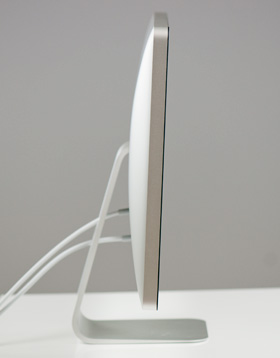 |
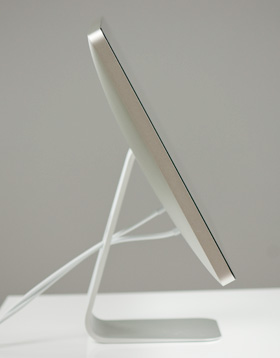 |
The display sits on an aluminum swivel base that allows for -5 degrees to 25 degrees of tilt along the horizontal axis. There's no height adjustment for the display either, only tilt. Personally, I use a height adjustable desk as I find it helps me avoid any carpal tunnel pain. Combined with a height adjustable chair, the lack of height adjustment on the display doesn't bother me. If you have a fixed height desk however, this may be a problem.
Aesthetically the Thunderbolt Display continues Apple's aluminum meets glass design language. The front of the display is all glass, while the edges and back are all aluminum. Along the top surface of the display is a mic for the integrated FaceTime HD camera. The outgoing 27-inch LED Cinema Display (still available for purchase online) sported a 640 x 480 camera, while the Thunderbolt Display ups capture resolution to 1280 x 720.
There's an ambient light sensor hidden in the top bezel of the display, but as always you can disable its functionality from within OS X.

There are two integrated speakers in the display, again unchanged from the previous LED Cinema Display.
Two cables attach directly to the display: a removable power cable and an integrated IO cable. Cable management is done through a round cutout in the aluminum stand. The IO cable is where things really change with the Thunderbolt Display. Instead of a breakout of three cables as was the case with the Cinema Display, there are now only two: MagSafe and Thunderbolt.
The MagSafe connector remains unchanged. If you've got any Mac that can be charged by an 85W MagSafe adapter, the Thunderbolt Display will charge said Mac. This feature alone is particularly awesome for notebook-as-a-desktop users since it allows you to just keep your actual AC adapter tucked away in your travel bag. For me I keep my MagSafe adapter in my bag and never take it out so I never have to worry about forgetting to pack it. Given how expensive MagSafe adapters are ($79 for an 85W), this is a nice feature for MacBook Air/Pro owners.
The Thunderbolt cable is obviously what gives this new display its name. Inside the Thunderbolt Display is an Intel Light Ridge Thunderbolt controller. The type of controller is important as it bestows upon the display some clear limitations. The biggest of course is the lack of support for all non-Thunderbolt systems. That's right, the only way to get video to the Thunderbolt Display is by using a Thunderbolt enabled Mac (or theoretically a Thunderbolt enabled PC). For Mac users that means only 2011 MacBook Pro, Air, iMac or Mac mini models will work with the Thunderbolt Display. Everyone else has to either buy a new Mac or stick with older displays.
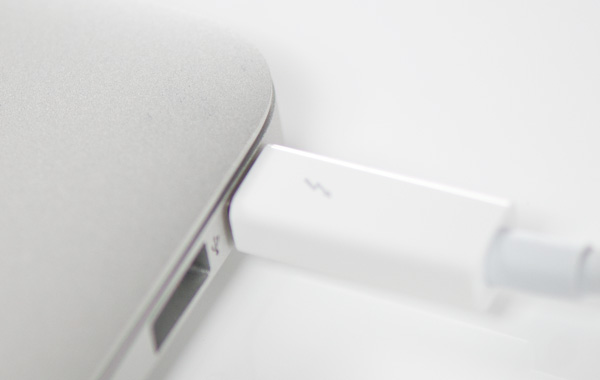
I believe the limitation here is actually on the cable side. A Thunderbolt cable can only transmit a Thunderbolt signal. Although DisplayPort is muxed in, if the display on the other end is expecting Thunderbolt and it receives DisplayPort it won't know what to do with it. It's possible Apple could have built in logic to autosense and switch between Thunderbolt and DisplayPort as inputs, but Apple traditionally employs clean breaks rather than long technology transitions. If Apple wants to ensure Thunderbolt gets adopted (at least by its users), this is the way to do it. As we learned from other legacy interfaces (e.g. PS/2, IDE), if you enable backwards compatibility you'll ensure the survival of systems that implement those interfaces. It's not so great for existing customers unfortunately.


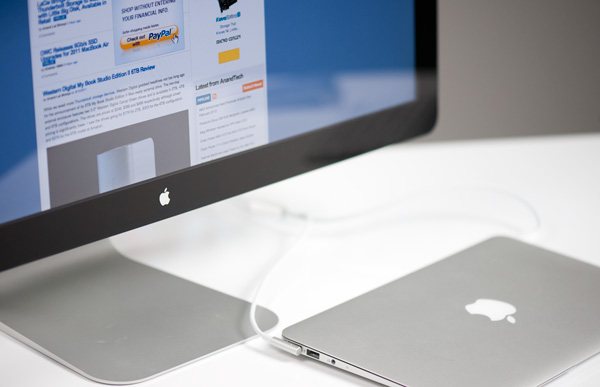
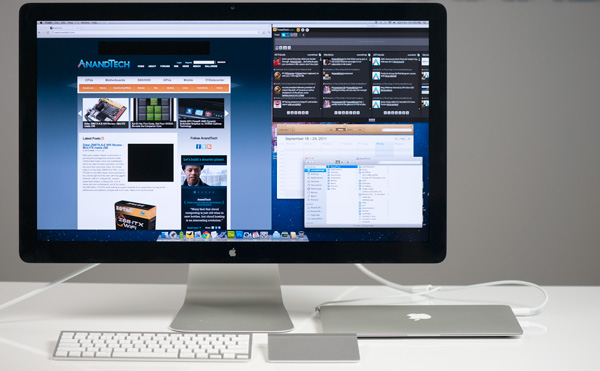
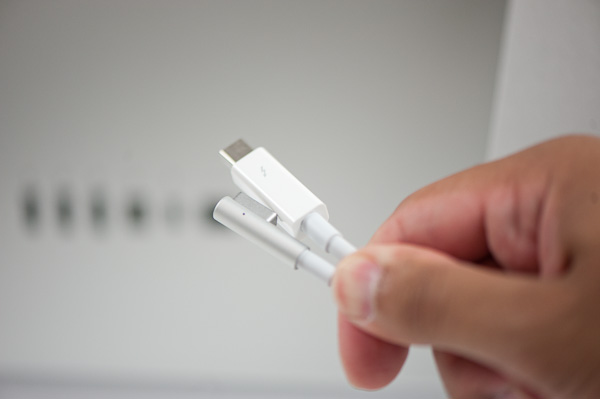








275 Comments
View All Comments
repoman27 - Monday, September 26, 2011 - link
Well, the display itself is driven by DisplayPort. The ATD does require Thunderbolt though, otherwise they couldn't have included all the other stuff. Apple is releasing this as an accessory for new Macs that have Thunderbolt ports. It does not make anything obsolete. You can continue to use pretty much any display on the market with either an older Mac that only supports DisplayPort or a new Thunderbolt equipped Mac although you might need an adapter or three. Most display manufacturers are probably not going to go the Thunderbolt route, and will stick with HDMI for 1920x1080 panels, DisplayPort for the higher resolution jobs, and DVI ports until the cows come home.Apple may soon cease production of discrete DisplayPort sink devices, but that in no way means that they've turned their back on the standard. Thunderbolt ports are indeed backward compatible with DisplayPort devices, but DP ports have no way of being forward compatible with Thunderbolt devices.
I find it odd that there are a lot of folks asking where all the Thunderbolt devices are, and then when one is released, everyone complains that they would need to buy a new Mac in order to use it. Thunderbolt devices are designed to be used with Thunderbolt enabled PC's, you're either in the market for them or you're not, end of story.
eureka_swe - Monday, September 26, 2011 - link
If you have say 2-3 FireWire 800 disk connected to the Display, do i need to Eject this on the Macbook Pro evry time i will disconnect the Display or is it just to pull out the Thunderbolt cable and the disk is still good ?its a big question for me that have 7 FW Disks :)
Constructor - Monday, September 26, 2011 - link
That you need to unmount volumes which are about to be disconnected doesn't change.The external FireWire controller is basically indistinguishable from one on the motherboard for the OS. And the file system is still the same.
So unmounting any external FireWire, USB and (directly) Thunderbolt device is a must and will remain so until the file system is fundamentally altered in that regard.
iSayuSay - Monday, September 26, 2011 - link
Agreed on some Anand's points. Hooking a Macbook Pro/Air with Thunderbolt onto that display may looks cool, it might instantly look like a desktop. But the real performance is never going to be excellent, it only become acceptable - very good range.If I going to cash in such amount of money (consider basic 11" MBA for $900 + 27" Apple Thunderbolt display for another $1000, and for elegance purpose .. don't forget TrackPad/MagicMouse + Wireless keyboard for another $140) ..
In total you already spend same amount with hi-end iMac 27" which performs much better, yeah sure .. it's not portable, but I don't carry around my MBA too much either :p
So I say .. while looks nice and cool, I'm not ready to follow world trend to go mobile with today's performance
dgingeri - Monday, September 26, 2011 - link
I flat out refuse to buy any Apple products. I have 3 reasons behind this now. At first, it was because they did so much business with Foxconn, and the horrible living conditions of the Foxconn employees who built Apple products. Then I found out about their excessive patent applications on a great many things that have been common habits of electronics manufacturers for over a decade. Now, I add on the excessive legal activity and flat out cheating in court trying to ban competing products.Apple is quite simply an evil company. Do not buy their stuff. Do not support the attempt at becoming a dictatorship of the world under the guise of business.
Mystermask - Sunday, October 9, 2011 - link
You're a hypocrite if you accuse Apple for what happens in chinese factories.1. Name me one brand that does not go for cheap as possible production. And why? Just have a look at those endless discussions where people try to prove that they can build a PC that has the same specs like e. g. a MacBook Pro but is even cheaper. How do you believe this is possible?Aren't you happy when you can buy a PC for €300 when all other cost 500€? Who do you believe is paying that bill? The "race to the bottom" has a long history that started in the PC industry when almost all HW vendors decided to go with DOS / Windows and vendors could only distinguish themselves in the market by being cheaper than others. And consumers gladly bought the cheapest - unable to distinguish value and price - effectively cutting into their own flesh because this has cost all production jobs in the PC industry in western countries.
2. Have a look at yourself. Do you wear Nike, Addidas, Reebook, Lacost, you-name-it? Do you use Dell, Acer, HP, HTC, Samsung, .. How and where are they produced?
..
All of a sudden, reality looks not as easy and religios blind Apple bashing is certainly neither a solution nor would that change anything for Foxconn or countless other factory workers in China, Vietnam or wherever people have to offer their work for cheap to survive because of western ignorance and greed.
The_Countess - Monday, September 26, 2011 - link
i cant help but notice that you could do all this with just 2 cables for far less money and without the expensive proprietary technology.1 display cable + 1 usb3.0 cable connected to a USB hub.
it'll even be fully backward compatible with practically every laptop still in operation on the planet!
you could even run the display over usb3.0 although I'm not sure how much bandwidth would remain after that.
repoman27 - Monday, September 26, 2011 - link
You can get more than 800 MB/s of throughput from a RAID connected to a USB 3.0 hub?... While getting over 780 Mbps over a USB 2.0 Gigabit Ethernet adapter?... (There are no USB 3.0 ethernet adapters in the wild yet.) While recording 720p video from a camera connected to the hub?... While playing back audio from a USB audio interface?... And how are you going to connect a FireWire device to your USB 3.0 hub? There's no adapters for that, and besides, you're out of ports on your hub because the only USB 3.0 hubs on the market have just 4 downstream ports. Looks like you'll need to get another hub and cable to connect a keyboard and mouse or USB disk.And yes, you could connect your version to any laptop and enjoy all of those devices sharing less than 40 MB/s of bandwidth, or connect it to a USB 3.0 enabled machine and get less than 400 MB/s. Thunderbolt gives you 2500 MB/s. A 2560x1440 display such as this requires 5.8 Gbps of bandwidth, USB 3.0 can't even hit 3.2 Gbps of real world throughput yet.
Constructor - Monday, September 26, 2011 - link
USB ist not remotely capable to drive a display at the same performance level as the built-in GPU in the computer can. Those USB graphics adapters are orders of magnitude slower than that.And both 10Gb/s input + 10Gb/s output at the same time as a high-res display (or even two of those with a small output performance hit) are completely out of range for even USB3.
Add to that the horrible latency problems you've got with USB, which are completely absent with Thunderbolt. (Which is one reason why you couldn't even have a full-performance FireWire port through USB3 since proper FireWire has very low latencies as well, which USB simply can't emulate.)
USB is a very complicated and not too fast peripheral interface.
Thunderbolt is effectively a part of the motherboard channeled through a thin cable to pluggable external motherboard expansions (the "motherboard" in the Thunderbolt display is effectively made a part of the computer's motherboard once you plug it in to the Mac).
Completely different deal.
AnnonymousCoward - Tuesday, September 27, 2011 - link
You're comparing USB to a GPU? ok..."orders of magnitude"? USB is 5Gbps; apparently the alternative is 500Gbps!! Sorry, it's not even 50Gbps, or even half of that.
"horrible latency problems you've got with USB" - I have no perceivable latency on my USB mouse, and I'm sensitive to it.
"USB is a...not too fast peripheral interface." - 5Gbps isn't fast? No external connection aside from raw video can utilize that!
Face it, you don't know what you're talking about.